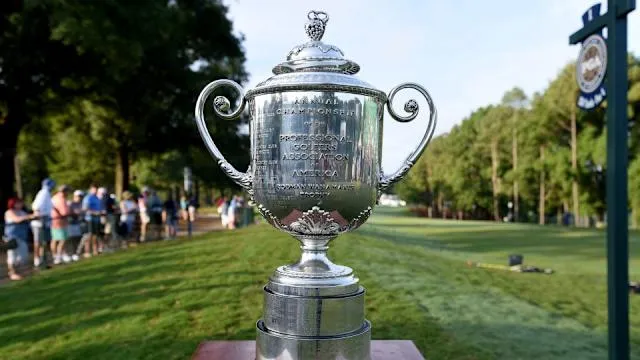The Curious Case of the Missing Wanamaker Trophy
The Wanamaker Trophy, awarded to the winner of the PGA Championship, is one of the most iconic pieces of silverware in the world of golf. This oversized jug, renowned for its intricate design and significant weight, has its fair share of stories—some bizarre, some humorous, and some downright intriguing. In recent times, the attention has turned towards Collin Morikawa, the young golf prodigy who claimed the Wanamaker Trophy in 2020, sparking debates about the trophy’s historical value, its physicality, and how it manages to outdrink nearly every other trophy in the sports arena.
A Symbol of Excellence
The Wanamaker Trophy is not just a trophy; it’s a representation of the pinnacle of professional golf. The PGA of America has awarded it since 1916 as a tribute to the founder of the PGA, Rodman Wanamaker. Unlike most trophies which are typically small and delicate, the Wanamaker stands out with its robust stature, measuring almost three feet tall and weighing roughly 27.5 pounds.
While many trophies symbolize victory, the Wanamaker Trophy has become synonymous with endurance and legacy. The trophy’s design, featuring a heavy silver exterior and beautifully ornate details including an inscribed base with the names of past winners, speaks volumes about golf’s rich history and the prestige associated with the championship it represents.
Collin Morikawa: Leaving a Mark
When Collin Morikawa made headlines by winning the 2020 PGA Championship at the tender age of 23, not only did he secure a major for himself but also ushered in a new era of golf with excitement and youthful exuberance. His victory at Harding Park in San Francisco was historic for myriad reasons: it was during a year overshadowed by the COVID-19 pandemic, and it marked him as one of the brightest stars on the golf circuit.
Yet, perhaps what was most captivating was Morikawa’s relationship with the Wanamaker Trophy post-victory. Tradition dictates that winners of major championships keep the trophy only for a year before it is returned, often leading to amusing anecdotes and heartfelt stories. For Morikawa, though, there was a twist that brought a profound sense of curiosity surrounding the trophy’s whereabouts.
The Quest for the Trophy
In a whimsical turn of events, Morikawa’s experience with the Wanamaker Trophy became somewhat of a mystery in the world of sports. Initially, upon winning, he celebrated the victory, sharing images with friends, family, and fans on social media. However, just a few weeks later, the trophy seemed to have vanished from public view.
The golfing community pondered: where could the Wanamaker Trophy have gone? Ironically, for a trophy known for its opulence, it was generating buzz precisely because no one could encounter it. Rumors swirled, and fans questioned whether the PGA Championship had a hidden tradition of mischief, taking the trophy across the globe for fun while keeping it from its rightful owner.
The Legend of the Trophy’s Bacchanal
To grasp the full essence of what makes the Wanamaker Trophy stand out—besides its shimmering silver surface—there’s also its unintentional reputation for engaging in untamed celebrations. This trophy has seen its fair share of wants and would-be celebrations through the decades.
Traditionally, upon winning the PGA Championship, players have been known to engage in celebratory toasts using their trophies, inadvertently giving birth to the legend that the Wanamaker Trophy can outdrink nearly every other trophy. This undoubtedly resonates with the spirit of competition and camaraderie inherent in golf, where rivalries aside, the post-game celebrations can bridge friendships and create lifelong memories.
An Unexpected Reunion
The trophy’s reappearance greatly amused fans. Following months of speculation and humorous conjectures about possible hiding places, the Wanamaker Trophy quietly made its way back into the limelight. Morikawa, during the subsequent year, often shared updates about its whereabouts, from showing it at local charity events to posting tantalizing glimpses on his social media, delighting fans eager for its return.
Engaging with the trajectory of the trophy also showcased Morikawa’s appreciation and love for the sport. It made fans reflect on how sporting artifacts can carry memories untouched by mere statistics—embodying moments of triumph, style, and tradition. As he made his appearances with the trophy, it drove home the idea that the trophy is as much Morikawa’s as it is a testament to all winners who came before him.
A Trophy with History
Since its inception over a century ago, the Wanamaker Trophy has been associated with legends of the game such as Walter Hagen, Jack Nicklaus, and Tiger Woods, all of whom left an indelible mark on the sport of golf. Each engraving on the trophy narrates its own saga of determination, skill, and sportsmanship.
The rich history that the Wanamaker Trophy embodies adds layers to its significance. As each new champion is engraved, they become part of an ongoing narrative that envelopes the golfing community. This intersection of individual triumph and collective legacy accelerates reverence and appreciation for the trophy well beyond its mere physical presence.
The Future of the Wanamaker Trophy
Looking forward, it is thrilling to imagine what the future holds for the Wanamaker Trophy and its subsequent champions. As Morikawa and other emerging young talents take center stage in professional golf, it brings forth a sense of rejuvenation to this storied trophy, combining tradition with innovation.
While the trophy can undoubtedly withstand hearty toasts and wear from time, the stories it helps create will continue to shape its legacy. Morikawa himself noted that winning this trophy was a pivotal moment in his career, amplifying his aspirations and enthusing a new generation about the game.
Conclusion
The curious case of the missing Wanamaker Trophy reflects more than just a playful anecdote in the realm of golf; it epitomizes a deeper connection between players, their victories, and the historical significance of the trophies they earn. As Collin Morikawa embarks on his journey in golf, the story of the Wanamaker Trophy serves as a reminder that trophies may come and go, but the moments they represent are eternal, creating echoes in sports that inspire generations long after the last putt has been sunk.
In the end, the Wanamaker Trophy stands as a testament not only to the spirit of competition but also to the joy, mischief, and memories that sports can gift us with, echoing the ages in a world that cherishes excellence, resilience, and camaraderie.







